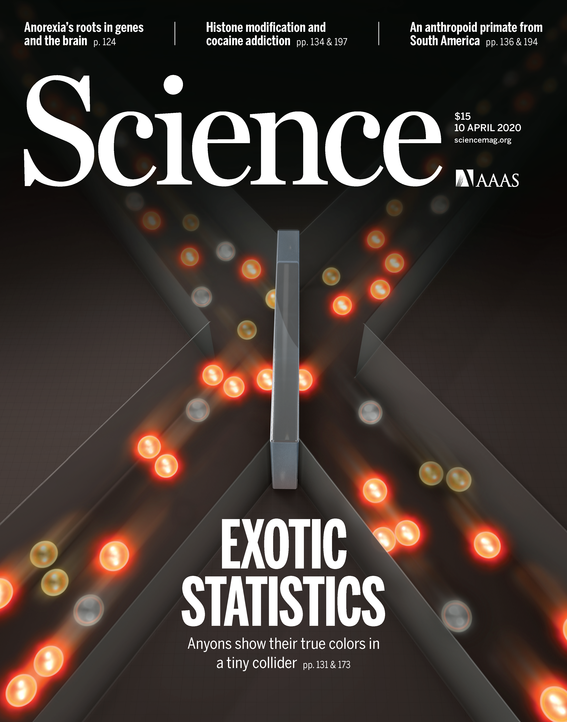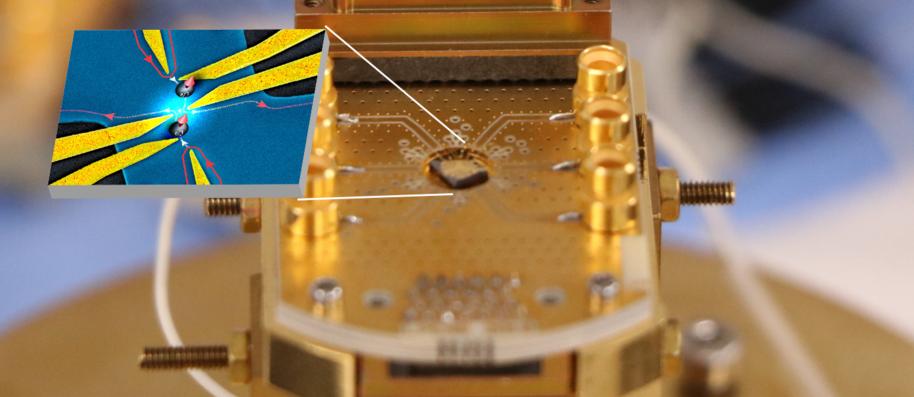Finally, Anyons reveal their exotic quantum properties

An Aalto University research fellow, Manohar Kumar is the co-first author on a paper published this week in Science. He and Hugo Bartolomei, the other co-first author, were part of a team at Ecole Normale Supérieure Paris to be the first to directly measure the quantum properties of exotic particles called an “anyons”. Anyons have been explored both theoretically and experimentally; but the true quantum nature of these particles was elusive until now. Anyons are interesting to scientists trying to build quantum computers, and other devices that exploit the properties of quantum physics. The significance of the work on the field of experimental quantum physics is so high, that the work has been selected to appear on the cover of Science.
What are anyons?
In the three-dimensional world we live in, there are only two types of particles: “fermions”, which repel each other, and “bosons” which like to stick together. A commonly known fermion is the electron, which transports electricity; and a commonly known boson is the photon, which carries light. In the two-dimensional world, however, there is another type of particle, the anyon, which doesn’t behave like either a fermion or a boson. The exact quantum nature of anyons lies in their wave nature, encoded in their quantum statistics. They were first proposed in the late 1970s, but direct experimental evidence of their quantum statistics hasn’t been conclusively shown until now.
‘Other researchers have been able to measure states with fractional charges before, which strongly suggested that anyons existed’ said Professor Gwendal Féve at École Normale Supérieure in Paris, who is in-charge of the research group that carried out the work. ‘However, the definitive proof of the existence of anyons was to prove that they behave like something that’s part way between a fermion and a boson, and that’s what we’ve been able to show for the first time with this experiment.’
Researchers have been trying to create and measure anyons by trapping them in nanosize boxes and measuring how they move around, but the results of those studies have been contentious. The team in this study believe they now have conclusive proof.
‘We created a very tiny particle collider, size of a human hair diameter. In this collider we smashed anyons to reveal their true quantum nature’ said Hugo Bartolomei, a graduate student who worked with Dr. Kumar and Prof. Féve on this project.
‘Our experiment worked like a 4-way junction in a road, with two roads in and two roads out. If you send fermions, which “hate” each other down the two roads in, they meet at the intersect but then leave down separate out roads. If you send bosons, which “like” each other, down the two roads in, they meet at the junction and then leave down the same out road together.’ explained Dr Kumar. ‘However, if you send anyons down the 2 roads in, they behave completely different: sometimes they combine, sometimes they don’t. Though they tend to bunch together like bosons, but the exact degree of togetherness lies in their wave nature’. Dr. Kumar and the team created particles they suspected to be anyons in a 2-dimensional layer of gallium arsenide, where they collided them in the 4-way junction. The experimental results showed this bunching tendency of anyons, replicating perfectly the mathematical model developed by theoretical groups at Leipzig, Harvard and ETH Zurich 4 years ago.
Any use for anyons?

This result is an important milestone for the field of condensed matter physics, as it provides experimental evidence for a particle that has only existed theoretically for almost a generation. The technique the researchers have used is also important as it allows other experimental scientists to reproduce and extend their research. In terms of real-world applications, anyons will still be confined to the lab for a long time but may have uses someday. ‘Our work until now focused on a type of anyon called “abelian” anyons,’ explains Dr Kumar. ‘However, a more exotic type called non-abelian anyons theoretically exists. These could be very useful because if you can interchange them, you can make them to form a qubit, which is essential for topological quantum computing. Our paper in Science shows a method for interchanging abelian anyons, so if it can be extended to non-abelian anyons then we might be able to open up a new avenue for exploring quantum computers.’ Dr Kumar now works on graphene with Professor Hakonen in the Low Temperature Laboratory at the Department of Applied Physics at Aalto University. ‘Graphene might be useful for make non-abelian anyons, so I’m looking to repeat the experiment in graphene and measure these exotic and exciting new particles.’ said Dr Kumar.
Read more news

Your voice gives away valuable personal information, so how do you keep that data safe?
With speech technologies becoming increasingly common, researchers want to make sure we don’t give away more information than we mean to.
Aalto in 2025: Quantum leaps, creative breakthroughs and solutions for a better life
Growth, technology and industrial renewal; human-centred solutions; health and everyday wellbeing; and enjoyable daily life and thriving communities.
Research Council of Finland establishes a Center of Excellence in Quantum Materials
The Centre, called QMAT, creates new materials to power the quantum technology of coming decades.






